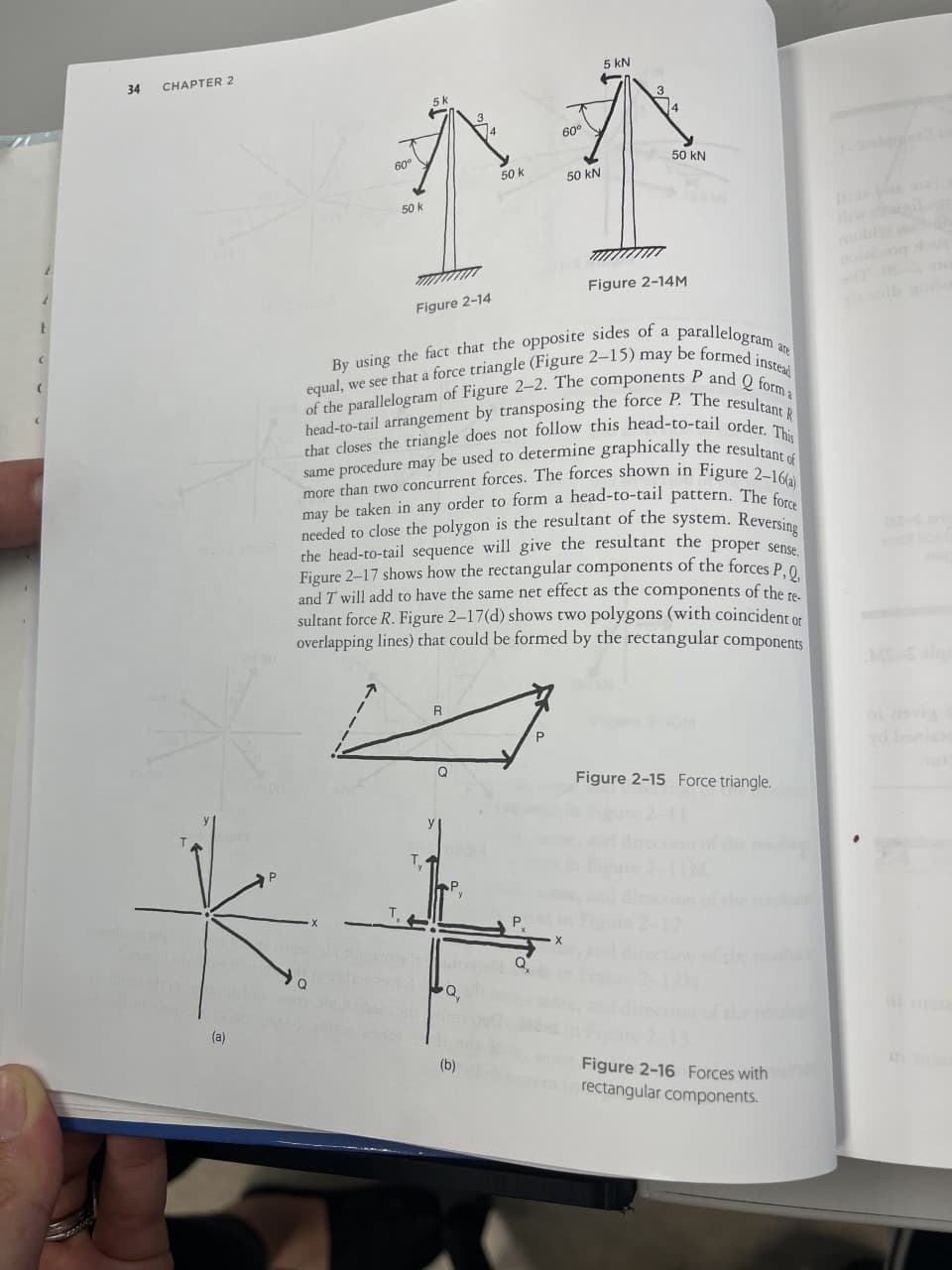College Physics
1st Edition
ISBN:9781938168000
Author:Paul Peter Urone, Roger Hinrichs
Publisher:Paul Peter Urone, Roger Hinrichs
Chapter3: Two-dimensional Kinematics
Section: Chapter Questions
Problem 70PE: Construct Your Own Problem Consider an airplane headed for a runway in a cross wind. Construct a...
Related questions
Question
2-5M Determine the magnitude ,sense ,and direction of the resultant of the three forces acting at the top of the pole in Figure 2-14M

Transcribed Image Text:34 CHAPTER 2
(a)
60°
50 k
Figure 2-14
T₁
R
Q
Q,
50 k
(b)
parallelogram
are
By using the fact that the opposite sides of a
of the parallelogram of Figure 2-2. The components P and Q form a
equal, we see that a force triangle (Figure 2-15) may be formed instead
head-to-tail arrangement by transposing the force P. The resultant R
that closes the triangle does not follow this head-to-tail order. This
same procedure may be used to determine graphically the resultant of
more than two concurrent forces. The forces shown in Figure 2-16(a)
may be taken in any order to form a head-to-tail pattern. The force
needed to close the polygon is the resultant of the system. Reversing
the head-to-tail sequence will give the resultant the proper sense
Figure 2-17 shows how the rectangular components of the forces P, Q,
and I will add to have the same net effect as the components of the re-
sultant force R. Figure 2-17(d) shows two polygons (with coincident or
overlapping lines) that could be formed by the rectangular components
P
60°
P
50 kN
5 KN
3
50 KN
Figure 2-14M
Figure 2-15 Force triangle.
Figure 2-16 Forces with
rectangular components.
Expert Solution
Step 1
According to the given data
F1=5k
F2=50k with 60 deg horizontal in Counter clockwise
F3=50k with
We need to find
Resultant of the Forces
Step by step
Solved in 2 steps with 1 images

Recommended textbooks for you

College Physics
Physics
ISBN:
9781938168000
Author:
Paul Peter Urone, Roger Hinrichs
Publisher:
OpenStax College

Physics for Scientists and Engineers, Technology …
Physics
ISBN:
9781305116399
Author:
Raymond A. Serway, John W. Jewett
Publisher:
Cengage Learning

College Physics
Physics
ISBN:
9781285737027
Author:
Raymond A. Serway, Chris Vuille
Publisher:
Cengage Learning

College Physics
Physics
ISBN:
9781938168000
Author:
Paul Peter Urone, Roger Hinrichs
Publisher:
OpenStax College

Physics for Scientists and Engineers, Technology …
Physics
ISBN:
9781305116399
Author:
Raymond A. Serway, John W. Jewett
Publisher:
Cengage Learning

College Physics
Physics
ISBN:
9781285737027
Author:
Raymond A. Serway, Chris Vuille
Publisher:
Cengage Learning

College Physics
Physics
ISBN:
9781305952300
Author:
Raymond A. Serway, Chris Vuille
Publisher:
Cengage Learning

Physics for Scientists and Engineers with Modern …
Physics
ISBN:
9781337553292
Author:
Raymond A. Serway, John W. Jewett
Publisher:
Cengage Learning

An Introduction to Physical Science
Physics
ISBN:
9781305079137
Author:
James Shipman, Jerry D. Wilson, Charles A. Higgins, Omar Torres
Publisher:
Cengage Learning